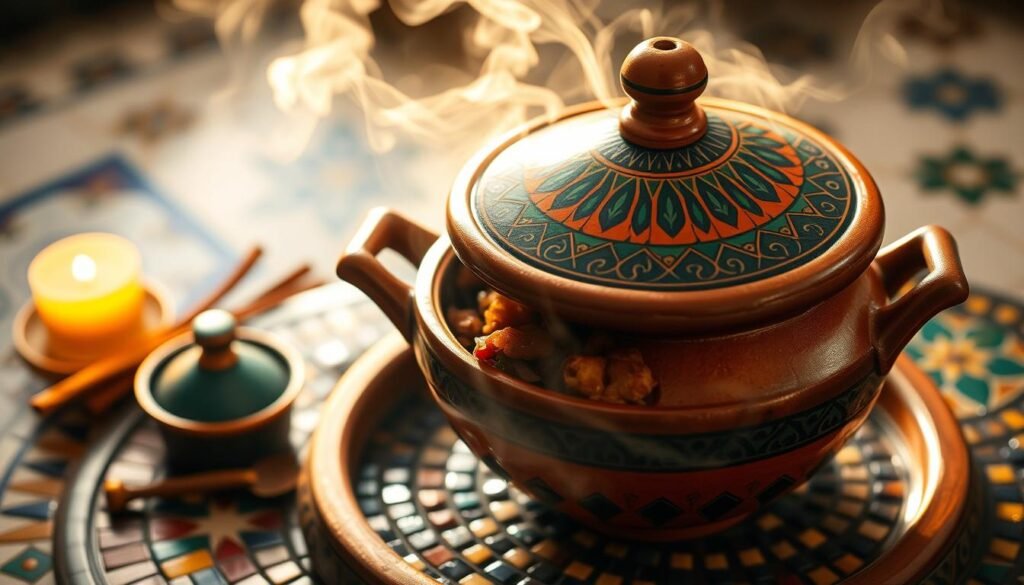Ever wondered why Moroccan cuisine is so celebrated? It’s known for its vibrant and diverse flavors. This tradition, filled with history, offers dishes that excite your senses. You’ll discover five must-try dishes that highlight Morocco’s rich flavors and culture.
From the famous Tagine to the comforting Couscous, and the exquisite Pastilla to the nourishing Harira, each dish has its own story. Don’t forget to try a refreshing cup of mint tea as we dive into this amazing food world.
Key Takeaways
- Moroccan cuisine is known for its rich and diverse flavors.
- Tagine is a cornerstone of Moroccan cooking, offering unique slow-cooked meals.
- Couscous is a traditional staple that comes with various preparations.
- Pastilla combines sweet and savory elements, making it a show-stopping dish.
- Harira is a nourishing soup that holds cultural significance during Ramadan.
- Mint tea is more than just a drink; it’s a symbol of hospitality in Morocco.
Introduction to Moroccan Cuisine
Start your journey into the world of Moroccan cuisine. It’s a mix of flavors from centuries of trade and cultural exchange. The country’s varied climate and geography offer a wide range of ingredients, from spices to fresh vegetables and meats.
At the heart of Moroccan dining are communal meals. Family and friends come together to enjoy delicious food. This tradition shows the importance of sharing meals, reflecting Morocco’s warmth and hospitality.
In Moroccan kitchens, traditional cooking methods are key. You’ll find slow-cooked tagines, steaming couscous, and hearty soups. Each meal is a chance to experience the unique flavors and textures of Moroccan cuisine. Now, you’re ready to explore specific dishes that showcase its essence.
The Uniqueness of Moroccan Flavors
Moroccan cuisine is known for its rich flavors, thanks to spices and local ingredients. This mix of tastes shows the local love for food and the history of trade. Exploring Moroccan dishes reveals a blend of tradition and new ideas.
Spices That Define Moroccan Dishes
In Moroccan cooking, spices are key. They include:
- Cumin: Adds a warm, earthy flavor.
- Coriander: Offers a fresh, citrusy note.
- Saffron: Infuses dishes with a unique aroma and vibrant color.
- Cinnamon: Often used in both savory and sweet dishes, providing warmth and depth.
These spices make Moroccan dishes special. They show the history of food exchange in the area. The mix of flavors gives a unique taste experience.
Regional Influence on Ingredients
The geography of Morocco affects its food. Coastal areas have fresh seafood, while mountains have herbs and veggies. Here’s how different areas add to Moroccan flavors:
| Region | Main Ingredients | Characteristic Dishes |
|---|---|---|
| Coastal | Fish, olives, citrus fruits | Grilled sardines, spicy fish tagine |
| Atlas Mountains | Barley, sheep, wild herbs | Traditional tagine, mountainside couscous |
| Saharan Desert | Dates, camel meat, spices | Aromatic date tagine, spiced camel stew |
Knowing about these areas helps us see why Moroccan food is so loved. It shows the culture and variety in Moroccan cuisine.
Moroccan Cuisine Demystified: Food You Must Try
Exploring Moroccan cuisine is like diving into a world of flavors and traditions. Here are five dishes you must try:
- Tagine: A slow-cooked stew in a conical pot, tagine mixes spices with lamb, chicken, or veggies. It’s a flavorful dish that shows off Moroccan cooking.
- Couscous: This dish is light and fluffy, often served with meat and veggies. Couscous is versatile and key to Moroccan meals.
- Pastilla: A mix of sweet and savory, pastilla has layers of dough, spiced meat, nuts, and sugar. It’s a dish for celebrations.
- Harira: A hearty soup with tomatoes, lentils, and chickpeas, harira is eaten during Ramadan. It’s comforting and a big part of Moroccan culture.
- Mint Tea: Known as Morocco’s national drink, mint tea is green tea with fresh mint and sugar. It’s refreshing and shows Moroccan hospitality.
Exploring Moroccan dishes is a journey of flavors and traditions. Here’s a table that highlights each dish’s key aspects:
| Dish | Main Ingredients | Flavor Profile | Cultural Significance |
|---|---|---|---|
| Tagine | Lamb, Chicken, Spices | Aromatic, Savory | Traditional Family Meal |
| Couscous | Semolina, Vegetables, Meat | Light, Fluffy | Staple for Feasts |
| Pastilla | Dough, Spiced Meat, Sugar | Sweet, Savory | Celebratory Dish |
| Harira | Tomatoes, Lentils, Spices | Hearty, Comforting | Ramadan Tradition |
| Mint Tea | Green Tea, Mint, Sugar | Refreshing, Sweet | Symbol of Hospitality |
Tagine: The Heart of Moroccan Cooking
Tagine is a key part of Moroccan cooking, both as a cooking vessel and a dish. Its conical shape helps in slow cooking, making food tender and juicy. Moroccan dishes cooked in a tagine are known for their rich flavors and spices.
What is Tagine?
A tagine pot has a base and a conical lid. This design keeps moisture in, making food moist. Traditionally made from clay, tagines are great for slow-cooked stews. Cooking with a tagine connects you to Moroccan culture.
Popular Tagine Recipes You Can Cook at Home
Cooking tagine dishes at home is fun and rewarding. Here are some traditional recipes to try:
- Chicken Tagine with Apricots: A mix of spices and sweet dried fruit.
- Lamb Tagine with Prunes: Tender lamb with savory and sweet flavors.
- Vegetable Tagine: A colorful mix of seasonal vegetables.
Here are some tips to make your tagine dish better:
| Tagine Type | Key Ingredients | Cooking Time |
|---|---|---|
| Chicken Tagine | Chicken, apricots, almonds, spices | 1.5 hours |
| Lamb Tagine | Lamb, prunes, onions, saffron | 2 hours |
| Vegetable Tagine | Carrots, zucchini, chickpeas, spices | 1 hour |
Choose your recipe, prepare your ingredients, layer them in the tagine, and cook on low heat. Your effort will result in a warm, comforting meal that captures Moroccan cooking’s essence.

Couscous: A Staple of Moroccan Meals
Couscous is a key part of Moroccan food, loved for its flexibility and cultural value. It has been a mainstay in Moroccan dishes for centuries. It symbolizes hospitality and unity, bringing people together during celebrations.
At special events, family gatherings, and community feasts, couscous takes center stage. It’s a true heart of culinary tradition.
The History and Significance of Couscous
Couscous has a long history, dating back to the 13th century. It’s a favorite in the Maghreb region, made from durum wheat. It’s a key part of Moroccan meals, often paired with meats and veggies.
Its preparation shows off culinary skill and cultural heritage. It highlights the joy of sharing meals with loved ones.
Different Ways to Prepare Couscous
There are many ways to make couscous, from traditional to modern. Here are some common methods:
- Steaming: The classic way, where couscous is steamed to make it light and fluffy.
- Boiling: A quicker method, where couscous absorbs water to make a satisfying meal.
- Salads: Cold couscous salads with veggies and dressings are refreshing for summer.
- Soups: Adding couscous to soups enhances flavors and texture, perfect for cozy dishes.
This beloved ingredient shows the rich traditions and flavors of Moroccan meals. It also adapts to new culinary trends.
Pastilla: A Sweet and Savory Delight
Pastilla is a standout in Moroccan cuisine, blending sweet and savory perfectly. It uses pigeon or chicken, mixed with spices, almonds, and sugar. This mix creates a savory pastry that’s a treat for the taste buds.
Making pastilla involves layers of a dough called warqa, like phyllo. This dough makes the pastry crispy on the outside and soft inside. It’s a clever mix of flavors that makes Moroccan cuisine special.
Pastilla is more than food; it’s a sign of celebration in Morocco. It’s served at weddings and big events. Its importance shows how much Moroccan cooking values creativity and tradition.
Harira: Nourishing Soup for Every Occasion
Harira is a beloved Moroccan soup that shows the heartiness of Moroccan cuisine. It’s often enjoyed at special times. This nourishing dish combines many ingredients for a delightful experience.
Ingredients that Make Harira Unique
The ingredients in Harira make it special. They add flavor and nutrition. Key parts include:
- Lentils
- Chickpeas
- Tomatoes
- Onions
- A variety of spices, such as cumin and coriander
This mix gives you essential nutrients and a true taste of Moroccan cuisine. The spices make the soup warm and rich, loved by many.
When to Serve Harira
Harira is a staple at special occasions, especially during Ramadan. It breaks the fast and symbolizes hospitality and joy. It’s also a hit at gatherings and celebrations, bringing people together.
Mint Tea: The Quintessential Moroccan Drink
Moroccan mint tea is loved by many in Morocco. It’s often called “Moroccan whisky.” This drink shows the importance of hospitality, with its special serving ritual.
Making Moroccan mint tea is a careful process. It starts with brewing strong green tea. Then, lots of fresh mint and sugar are added to get the right taste. Each step shows how much Moroccans value sharing tea with others.
Drinking Moroccan mint tea is more than just a refreshment. It’s a way to connect and build friendships. It gives a glimpse into Moroccan culture and its traditions of togetherness.
| Element | Description |
|---|---|
| Ingredients | Green tea, fresh mint leaves, sugar |
| Preparation Method | Traditional pouring technique from a height |
| Cultural Significance | Symbol of hospitality and friendship |
| Serving Occasions | Social gatherings, celebrations, daily rituals |
| Variations | Different regions may use varying styles or additional herbs |
Conclusion
Moroccan cuisine is a vibrant mix of flavors that deserve your attention. This summary shows the key dishes and their cultural importance. From the slow-cooked tagine to the warm harira, these dishes open a door to a fascinating world.
Trying these dishes is essential for a complete culinary journey. They are more than food; they share stories of tradition and art. Whether you eat out or cook at home, you’ll grow to love this cuisine even more.
Start your adventure into Moroccan flavors today. Each bite connects you to a rich history and joyful celebrations. Your journey into Moroccan cuisine is just beginning. Dive in, experiment, and let these flavors take you to Morocco’s lively markets and streets.
